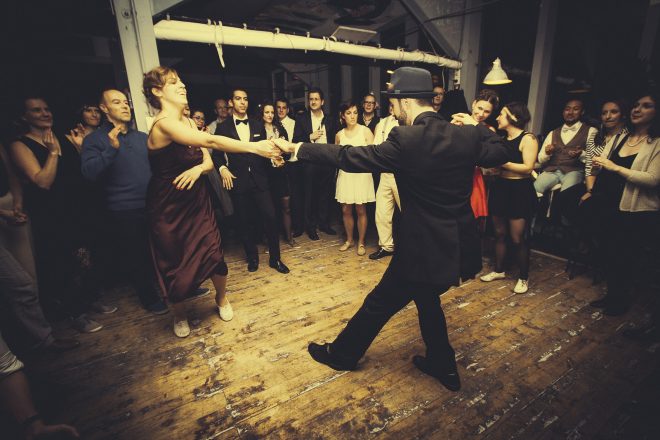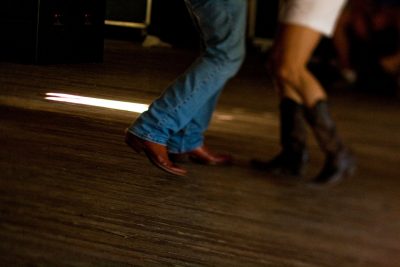Everyone should have a hobby. You need time to cut loose, relax, and spend some time doing something that puts a smile on your face. It makes you healthier and happier, and it allows you to focus better when it is time to work.
As a competitive dancer who spends hours in the studio every day, people tend to look at me funny when they ask me what I do to relax and I say, “I go dancing.” When I was touring and host families would ask us what we were going to do after strike, it was always the same: we found a local venue and took over the floor and just danced.
Even if something is your job or your structured, very goal-oriented, competitive hobby, it can still be your release. What’s always kept me sane is that social dancing reminds me of the joy and the magic that technique practice can suck out of dancing.
If you’re looking for a way to reinvigorate your dancing without taking another master class or a crossover workshop, consider social dancing. It’s fun, relaxed, and the inherent improvisation not only improves your partnering, but allows you to let go and just feel the movement without worry of mistakes.

Reasons to Go
For the average person, learning to dance might be a way to avoid making a fool of themselves at a wedding or to get the exercise that their doctor has been encouraging. It’s also a great way to meet people and find a constructive social outlet — the number of people in my dance classes who just want to get out of the house and make friends is more than you’d expect.
For trained dancers, social dancers stand to benefit even more. Not only will your brain benefit from the social aspect, you’ll be challenged mentally by adapting to a new style of dance. Whether you’re male or female, your improvisation will improve, and the musicality demanded by different rhythms will influence the way you listen to music. The greatest perk, though, is the lead and follow connection that you develop. Learning to listen to your partner in a way that allows you to take what they’re giving you, react to it, and respond to make the dance grow is an amazing skill. Cliché as it is, the best dances feel less like two people following steps and more like old friends staying up late and sharing secrets.
Choosing Your Dances
Deciding where to start is the hardest part of taking a social dance class — there are so many options! For some, it might be obvious; salsa calls to your sassy personality or you love the unique flow of west coast swing. If you don’t have a clue, though, here’s a brief (and definitely non-exhaustive) breakdown of social dance styles:
- Ballroom can cover a lot; social ballroom classes often encompass waltz, tango, foxtrot, cha cha, rumba, and a swing of some sort. They’re general overview classes that let you dip your toes into a little bit of everything, and some classes might even introduce salsa.
- Latin dances are a bit more focused, and almost everything will be danced to highly rhythmic music. These classes may cover cha cha, rumba, salsa, bachata, lambada, and merengue.
- Club styles tend to be a little more throwback, and are designed to be danced to the popular music of a particular era. The two most common club dances are hustle (yup, think 70s, disco, bell-bottoms and big hair) and nightclub two-step. The dances couldn’t be more different in tempo and feel, but they’re both easy to pick up and fun to do.
- Swing is a large and varied segment of dances covering everything from single-time swing to lindy hop to west coast swing. Often, dancers who pick up swing tend to stick to a specific style and attend events particular to that dance.
- Country is an interesting mix of improvised dances, choreographed partner dances, and line dancing. A lot of the movements tend to be very repetitive, with variation opportunities for those who become comfortable. Some of the most popular dances are the country two step, cowboy swing, and the sweetheart stroll.
- Depending on the region you’re in, there are undoubtedly more dance classes available. Some other common styles that don’t truly fit into a category above include kizomba (an African tango), zouk, and Argentine tango.
The type of class you sign up for, as well as the teacher, will determine what dances you learn. Often, a course description or advertisement will list the dances covered. If you’re unsure and can’t find the information, reach out to the instructor and check.
Social Dance Vocabulary
A huge part of social dance classes is introducing non-ballroom dancers to the world that is social dancing. As such, these classes are exceptional for learning relevant phrasing and terminology. In case you want to be extra prepared on your first day, here are some basics:
- Lead: the partner responsible for “directing” the dance and giving cues (conventionally the male partner).
- Follow: the partner executing on and maintaining the movement initiated by the lead (conventionally the female partner).
- Frame: the point of connection and a path of communication between a lead and a follow. Frame may vary in style from dance to dance.
- Figure: a standardized series of steps that create a recognized pattern or movement (for example, an outside turn or a box step).
- Syllabus: the list of recognized figures for each dance, divided by level and difficulty.
- Frame: the upper body position of a partnership, encompassing the arm, shoulder, and neck line.
- Line of dance: a path traveling around the perimeter of the dance floor in a counterclockwise direction. In social dance, when more than one dance suits the music, the stationary dancers occupy the center of the floor, and the faster you travel, the closer you’ll dance to the room’s perimeter.
Beyond these generic terms, each teacher, community, and region will have their own set of words and phrases. Vocabulary also adapts to each dance style, so wording in one class may not be exactly the same as another.

What to Wear
Social dance classes are less formal than a technique class would be, and the dress code tends to reflect that. You can usually wear anything that you can move in, and attendees will be dressed in everything from casual jeans to almost-Sunday-best to athleisure. In social classes, the only true rule of thumb is to avoid clothing that might get in the way or make a partner uncomfortable. Super skimpy tops should be avoided, as well as overly baggy clothing or items with ties or excessively loose sleeves.
Preferred shoe style will depend greatly on the style of dance you plan to pursue. Generally speaking, you want a sueded sole, or at least a sole that allows you to turn. Rubber or other grippy soles can quickly result in a sprained ankle or unhappy knees. Beyond that, sole flexibility, heel height, and style of the shoe is up to you and what’s appropriate for the dance. Social dancers tend to prefer a lower heel because it’s easier on the foot and there isn’t heavy emphasis on technique — anything you can move well in is free game. Your instructor will have the best advice about shoes for his or her class.
Attending Dance Classes and Events
Social dance offers every kind of event under the sun, and once you’re in the community, they’re not hard to find. Here are a few notes on the opportunities available:
Classes
As noted at the beginning of this post, the primary function of a social dance class is to impart knowledge of a dance, it’s conventional steps, and the skills necessary to execute those steps in a social setting. Classes will focus on lead and follow skills, the unique counting and rhythm for each dance, and basic figures and how to cue them.
You don’t usually need a partner to attend class; because you’re theoretically learning how to dance with strangers, the teacher will rotate partners throughout the class so that students can experience different leads and follows. When you’re meeting multiple people throughout a class, you’ll be expected to introduce yourself and be polite with all your partners. You may even have a lead or a follow in the class outside of the conventional gender roles; social dancing is more tolerant of female leads and male follows than competitive and technical dancing is.
It’s also important to maintain good personal hygiene for classes and other events. Dancing is a physical activity and sweating is expected, but dancing with a partner who smells like they haven’t showered in a week can quickly ruin an experience. Another aspect of hygiene and respect for the class is never attending while you’re sick. Even if you feel capable, you don’t want to share your cold with everyone in the studio.
Social Events
Learning to social dance actually requires, you know, social dancing. Studios and communities often host a variety of social events open to everyone from total beginners to super advanced. After a few classes, you may feel ready to test your mettle by dancing with new people. Even if you don’t, go anyway; the fastest way to become proficient is to just do it. Plus, it’s a great way to get to experience all the personality and subculture that comes with each community.
If you’re nervous to go by yourself, ask a friend from class to go with you or ask your teacher for advice. Some social events have unique etiquette that might not be immediately apparent. At a milonga (an Argentine tango social), you’ll dance with the same person for three songs in a row, instead of leaving the floor after one. It’s considered an insult to leave a partner before three songs are over. Luckily, most communities are full of people willing to show you the ropes.
Conventions and Competitions
Once you’ve become comfortable with social dancing, the next step is to attend a convention or competition. While most social dances occur within a larger convention setting, not all conventions have a competitive element. In general, conventions are massive dance parties where you go to learn, dance your feet off, and strut your stuff with amazing new people.
Conventions are often located in large metropolitan areas and cooperatively hosted by the local communities. Dancers from all over will travel to take workshops from professionals and spend the weekend practicing with each other. Don’t be worried, though; while the classes are structured, the rest of the time often feels like a huge dance party with a few hundred of your closest friends. You’re always going to learn something new, and there are no shortage of leads and follows to go around.
Get to It!
Social dancing is an amazing way to meet new people, pick up a hobby that’s as good for brain as it is for your body, and improve your partnering skills. You can be as invested as you want to be — there’s nothing wrong with just taking a class or attending as many conventions as possible. The point is to have fun and enjoy the journey, so stop waiting and go!
 Alyssa Robinson is a lover of words and movement who happily resides in the Pacific Northwest. She started dancing at 19 when the ballroom (and Latin) bug bit her, and she hasn’t stopped since. If she’s not writing about food, fitness, and dance, she’s in the studio training for her next ballroom competition.
Alyssa Robinson is a lover of words and movement who happily resides in the Pacific Northwest. She started dancing at 19 when the ballroom (and Latin) bug bit her, and she hasn’t stopped since. If she’s not writing about food, fitness, and dance, she’s in the studio training for her next ballroom competition.

Dance Advantage welcomes guest posts from other dance teachers, students, parents, professionals, or those knowledgeable in related fields. If you are interested in having your article published at Dance Advantage, please see the following info on submitting a guest post. Read posts from guest contributors.

